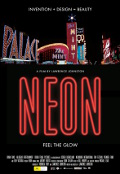
Directed by
Lawrence Johnston
83 minutes
Rated PG
Reviewed by
Chris Thompson

Neon
Synopsis: An extensive documentation of the history, science, art, design and cultural impact of neon lighting from its beginnings in Paris to its adoption as an American icon.
With Neon, director Lawrence Johnston revisits the territory he covered in his 2008 doco, Night, only this time he’s exploring that most magical of forms that illuminates the urban darkness; neon signs. The material here is quite fascinating and, as one might expect, the big screen (courtesy of Eron Sheean’s photography) does justice to the signs themselves which are visually entrancing, especially those from the post-war period when their colour and animation became such a part of the visual landscape of cities like New York and Las Vegas.
Johnston takes us right back to the beginnings of outdoor, large scale illumination with incandescent light bulbs before walking us through the history of how neon lighting and its application to signage was developed, quickly superseding blinking bulbs as the popular choice for advertising and branding. As we move through the early part of the twentieth century, we’re accompanied by a wealth of archival footage and music of the times intercut with a wide range of talking heads who represent the neon industry, its fans and those who have taken it upon themselves to archive and preserve what the advent of the LED globe is fast making a lost feature of the metropolitan night skyline. Here we also learn about the dying art of the neon bender; those artisans who job it was to heat and bend the glass tubes that formed the letters and images. Like typesetters in a newspaper office, their skill is fascinating to watch as much for its archaic craft as for what it represents about progress and the way new technologies reshape the workforce.
The structure of the film is quite similar to Johnston’s 1994 doco classic, Eternity, in that it follows the history of its subject with an exploration of its cultural impact and, whilst Eternity is a far more affecting and socially powerful film, his thesis on how neon signs came to mean different things to different generations – from its beginnings as a signifier of happiness and gaiety to its post war symbolism of the darker more nefarious side of life - is compelling. His examples include the way neon lighting has been used in films from the fabulous frivolity of Busby Berkeley and Mervyn LeRoy’s neon light sequence in Gold Diggers of 1933 to its foreboding presence in Hitchcock’s Vertigo. It’s such a shame that he wasn’t able to include Francis Ford Coppola’s gloriously neon infused One From The Heart (1982) - reportedly the budget wouldn’t accommodate it.
The content of Neon is certainly enough to hold our interest and the talking heads – neon geeks one and all – are entertaining enough, but it’s a film that really relies on being seen on the big screen. Its stunning neon visuals are its cinematic draw-card and save the film from being just a good history and social studies lesson.

Want more about this film?


Want something different?




